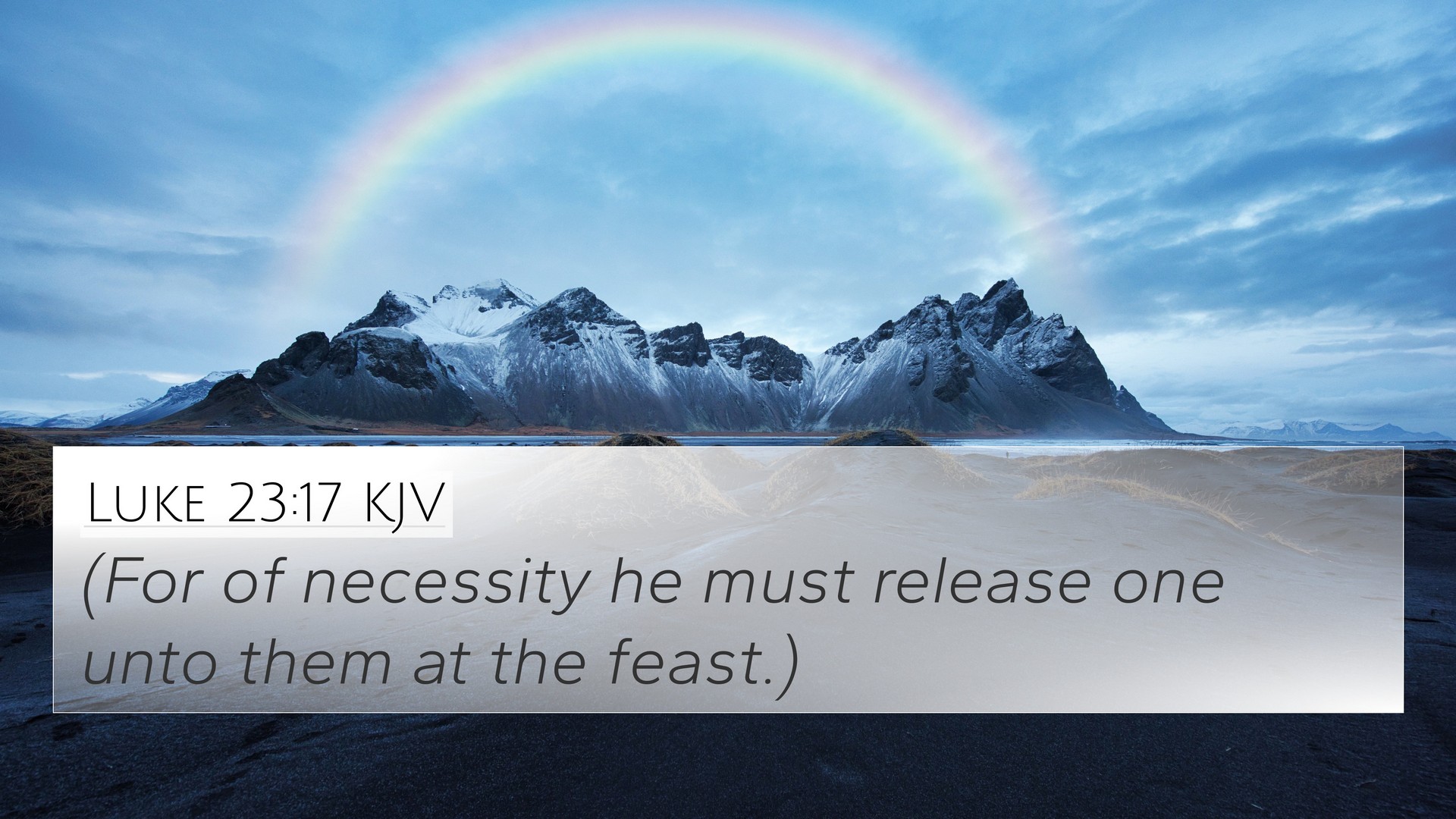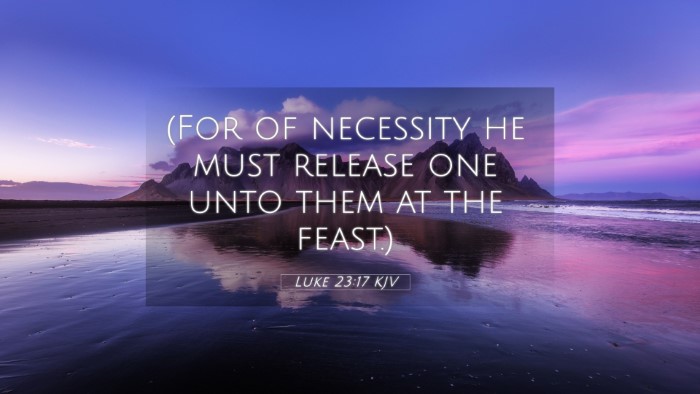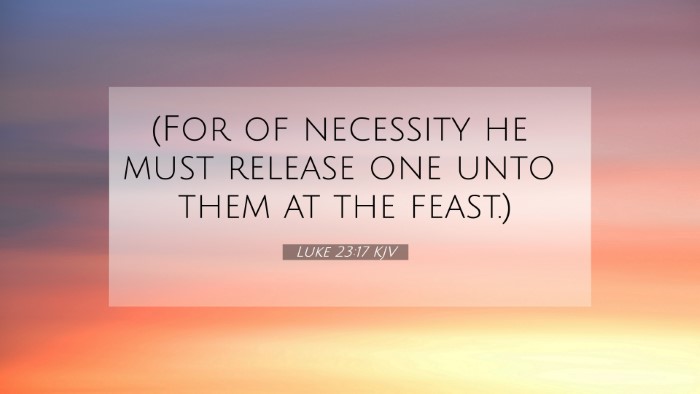Bible Verse Meaning: Luke 23:17
Luke 23:17 states, "For of necessity he must release one unto them at the feast." This brief yet significant verse holds substantial meaning and is often examined in the context of the events surrounding the passion of Christ. To fully appreciate the implications of this verse, we turn to insightful commentary from respected biblical scholars such as Matthew Henry, Albert Barnes, and Adam Clarke.
Contextual Overview
In the context of the crucifixion narrative, this verse highlights the Roman governor Pontius Pilate's custom of releasing one prisoner during the Passover feast. The underlying theme pertains to the choice offered to the Jewish populace between Jesus and a criminal, Barabbas. This situation frames a critical decision, thereby illustrating the rejection of Christ by the people.
Commentary Insights
-
Matthew Henry:
Henry emphasizes the nature of the release as a public tradition, portraying it as a means of appeasing both the populace and the religious authorities of the day. He further underscores how this act is both literal and symbolic of Christ's larger sacrifice, highlighting the profound irony; the innocent was rejected, while the guilty was set free.
-
Albert Barnes:
Barnes elaborates on the necessity of this release, indicating that Pilate likely viewed it as a political strategy to quell unrest during the festival. He suggests that the choice presented to the crowd serves as a pivotal moment in biblical history, where human choice directly encounters divine providence. The tension between the demand for Barabbas' release and the innocence of Jesus showcases the sinful nature of mankind.
-
Adam Clarke:
Clarke's commentary brings to light additional historical context, noting the importance of the feast. He elaborates that the choice was far more than mere tradition; it was a moment charged with spiritual significance. Clarke connects this moment to the greater narrative of redemption, asserting that the release of Barabbas represents the sinfulness of humanity, juxtaposed against the righteousness of Christ.
Thematic Connections
This verse serves as a notable point for examining the connections between various scriptures. The act of releasing a prisoner during Passover can be seen as a precursor to the ultimate sacrifice of Christ. Below are some related Bible verses and themes:
- Matthew 27:15: This verse parallels Luke 23:17 by explaining the same custom of releasing a prisoner, offering a deeper understanding of the narrative.
- John 18:39-40: Similar to Luke 23:17, this passage provides insight into the choice between Jesus and Barabbas, emphasizing the crowd's role in condemning Christ.
- Isaiah 53:3: A prophetic scripture referring to the Messiah as despised and rejected, much like the rejection Jesus faced during this choice.
- 1 Peter 2:24: Connects with the theme of Christ carrying our sins, underscoring the gravity of the choice presented at the trial.
- Romans 5:6-8: Highlights the nature of Christ's sacrifice — dying for the ungodly, resonating with the idea of Barabbas' release.
- Mark 15:6-15: Similar context as in Luke, reinforcing the necessity of the release during the Passover festival.
- Acts 3:14-15: This passage recounts the condemnation of Jesus by the people, linking back to the rejection seen in Luke 23:17.
Cross-Referencing Biblical Texts
The narrative of Luke 23:17 encourages deeper examination of interrelated biblical texts. When engaging in comparative Bible verse analysis, readers can effectively discern the thematic continuity of Christ's suffering across the Scriptures.
Significance of Cross-Referencing
Understanding the connections between Bible verses enhances the interpretation of scriptural texts. The tools for cross-referencing can lead to discoveries such as:
- Bible concordance: Essential for identifying where similar words and themes recur in scripture.
- Bible cross-reference guide: Useful for tracing strong thematic links across both Testaments.
- Cross-reference Bible study: Can reveal the profound interconnectedness of stories and teachings throughout scripture.
- How to use Bible cross-references: Learning effective methods can deepen one's understanding of biblical narratives and their implications.
Conclusion
Luke 23:17, though seemingly straightforward, is rich with meaning and context. The inter-Biblical dialogue it creates adds depth to our understanding of Scripture. Through cross-referencing biblical texts and identifying connections between verses, one can gain a more profound insight into the sacrificial nature of Jesus and the choices of mankind. This verse stands as a reminder of the pivotal moments in the story of salvation and the cost of redemption.
As readers explore cross-referencing themes and biblical narratives, they uncover an intricate tapestry that connects the past with present faith. Encouraging a practice of linking Bible scriptures could lead to transformative insights and a deeper relationship with the text.


